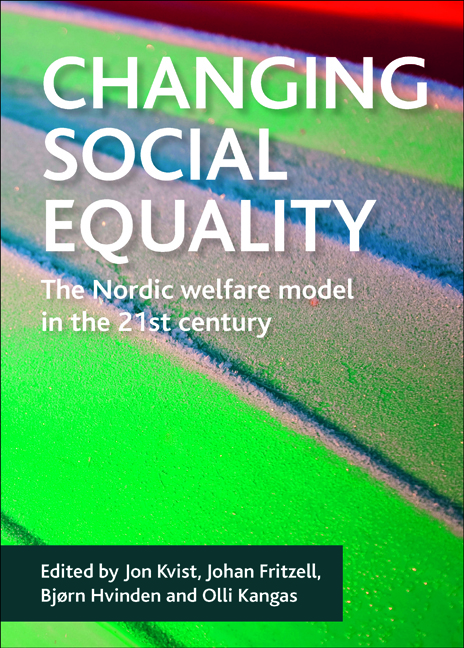Book contents
- Frontmatter
- Contents
- List of tables and figures
- Notes on contributors
- Acknowledgements
- one Changing social inequality and the Nordic welfare model
- two Anti-immigration attitudes, support for redistribution and party choice in Europe
- three Do we all (dis)like the same welfare state? Configurations of public support for the welfare state in comparative perspective
- four Eroding minimum income protection in the Nordic countries? Reassessing the Nordic model of social assistance
- five Equality in the social service state: Nordic childcare models in comparative perspective
- six Welfare state institutions, unemployment and poverty: comparative analysis of unemployment benefits and labour market participation in 15 European Union countries
- seven Social inequalities in health: the Nordic welfare state in a comparative context
- eight Income inequality and poverty: do the Nordic countries still constitute a family of their own?
- nine Is immigration challenging the economic sustainability of the Nordic welfare model?
- ten Nordic responses to rising inequalities: still pursuing a distinct path or joining the rest?
- Index
four - Eroding minimum income protection in the Nordic countries? Reassessing the Nordic model of social assistance
Published online by Cambridge University Press: 01 September 2022
- Frontmatter
- Contents
- List of tables and figures
- Notes on contributors
- Acknowledgements
- one Changing social inequality and the Nordic welfare model
- two Anti-immigration attitudes, support for redistribution and party choice in Europe
- three Do we all (dis)like the same welfare state? Configurations of public support for the welfare state in comparative perspective
- four Eroding minimum income protection in the Nordic countries? Reassessing the Nordic model of social assistance
- five Equality in the social service state: Nordic childcare models in comparative perspective
- six Welfare state institutions, unemployment and poverty: comparative analysis of unemployment benefits and labour market participation in 15 European Union countries
- seven Social inequalities in health: the Nordic welfare state in a comparative context
- eight Income inequality and poverty: do the Nordic countries still constitute a family of their own?
- nine Is immigration challenging the economic sustainability of the Nordic welfare model?
- ten Nordic responses to rising inequalities: still pursuing a distinct path or joining the rest?
- Index
Summary
Means-tested social assistance and minimum income benefits mitigate financial hardship and alleviate poverty. Whereas social insurance aims to provide protection against loss in work-related income, and family or child benefits are intended to compensate households for additional child-related costs, social assistance is meant to provide a safety net for households that have insufficient incomes and that do not qualify for other types of public support. Several scholars point to the necessity of a system of well-functioning minimum income benefits. According to Marshall (1950), the provision of a certain minimum income for all members of society is among one of the core elements of social citizenship. Rawls (1971) acknowledged the role of social minimums for the creation of just societies, because these minimums guarantee the meeting of short-term basic needs. More recently Leibfried (1993) has argued that the most appropriate test of full social citizenship for all is to ask what the welfare state does for the poor and destitute. Whatever their justification, minimum income benefits constitute important social policy means of reducing inequality.
Nordic social assistance and minimum income benefits have had a relatively marginal role compared with other welfare policy schemes. Nonetheless, benefit levels have been high, something that is of relevance for effective poverty alleviation. However, as last-resort social safety nets are changing, this chapter analyses whether the Nordic countries still have such a helpful model. We compare changes from 1990 to 2010 in Denmark, Finland, Norway and Sweden with those of Germany, the Netherlands and the United Kingdom (UK). As a last-resort benefit, social assistance does not exist in isolation from other welfare state structures: its role and importance depends on the organisation and functioning of other forms of social protection. This dependence is one reason why comparisons of social assistance must focus on both institutional structures and their outcomes. More precisely, the chapter asks and answers the following three questions.
First, is Nordic social assistance moving in the direction we would expect from the recognition of an encompassing or universalist Nordic model (Korpi and Palme, 1998)? This model suggests that means-tested social support, such as social assistance, is comparatively generous and has a marginal and diminishing role for income protection, both in terms of expenditure and caseloads.
- Type
- Chapter
- Information
- Changing Social EqualityThe Nordic Welfare Model in the 21st Century, pp. 69 - 88Publisher: Bristol University PressPrint publication year: 2011



